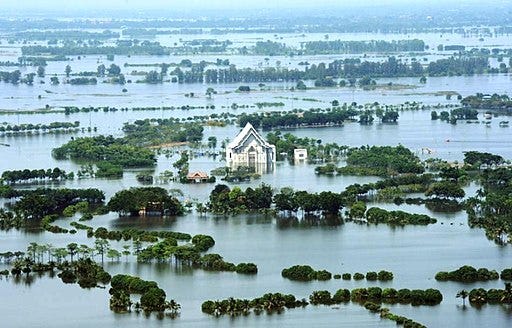Escalating Floods and more threats: Thailand Braces for Widespread Impact as Global Trends Intensify
From the deadly flash floods that recently swept through Central Texas to the inundated streets of Bangkok, a disturbing global pattern is emerging: floods are becoming more frequent, more intense, and more destructive. This escalating crisis underscores the growing impact of climate change, rapid urbanization, and inadequate infrastructure in both developed and developing regions. What was once considered extreme weather is becoming the new normal, raising urgent questions about how prepared the world is for a future where rising waters may define our landscapes, economies, and lives.
The global climate crisis has brought with it a troubling surge in extreme weather events. Among the most disruptive and deadly are floods, which are now occurring with increased frequency and intensity around the world. In Southeast Asia, the monsoon season has long presented flooding risks, but recent years have seen unprecedented rainfall patterns and more widespread damage. Thailand is once again on high alert as its central authorities brace for another period of intense rainfall and elevated river levels.
On July 6, 2025, the Office of Natural Water Resources (ONWR), in coordination with key agencies such as the Meteorological Department and the Department of Disaster Prevention and Mitigation, issued an urgent nationwide warning for the period of July 6–12. The alert advises the public to prepare for flash floods, runoff, and landslides—especially in mountainous and low-lying regions. With the Mekong River's water levels also rising sharply, downstream provinces are at heightened risk of widespread inundation.
Also, the Stockholm Environment Institute (SEI) and the ONWR just signed last month a five-year agreement to strengthen Mekong Region water governance. The Memorandum of Understanding includes tackling floods and drought risks.
Current Situation
Warning No. 10/2025 marks a significant escalation in Thailand’s seasonal flood preparedness. Heavy to very heavy rainfall is forecast to affect multiple provinces, with a high probability of flash flooding and landslides. As of this writing, vulnerable regions include the northern highlands, central plains, and northeastern areas adjacent to the Mekong River.
This situation mirrors broader global trends. In the United States, for example, flash floods have recently devastated parts of Texas, while similar rainfall events have disrupted daily life and agriculture across parts of South and Southeast Asia. These developments suggest that floods, once viewed as largely regional disasters, are now a shared global concern.
The ONWR has intensified coordination efforts with key governmental bodies. The Royal Irrigation Department is managing reservoir discharges and closely monitoring water retention systems, while the Department of Mineral Resources is identifying landslide-prone zones. At the local level, district officials have been instructed to update evacuation plans, establish emergency shelters, and ensure the availability of supplies such as food, clean water, and medicine.
Underlying Causes and Contributing Factors
A combination of meteorological, geographical, and human-induced factors has contributed to the rising flood risk. Climate change remains the primary driver, increasing the intensity and unpredictability of rainfall. Additionally, land development and deforestation have reduced the land’s natural ability to absorb water, exacerbating runoff and erosion. Urbanization without adequate drainage infrastructure further compounds the issue.
In the case of the Mekong River, upstream dam operations and rainfall variations across neighboring countries also influence water levels in Thailand. These transboundary factors underscore the need for international cooperation in water management and flood forecasting.
What Can Be Done?
While emergency response is crucial, the long-term solution lies in building resilience through sustainable water management, infrastructure investment, and climate adaptation. Thailand has made progress in developing early warning systems, but these must be complemented by:
Community-based disaster preparedness: Local knowledge and quick mobilization can save lives during fast-moving events like flash floods.
Reforestation and watershed management: Protecting and restoring forests can mitigate landslide risks and improve water absorption.
Smart infrastructure: Upgrading irrigation canals, flood barriers, and urban drainage systems is essential to cope with intense rainfall.
Education and communication: Ensuring that the public receives timely and clear information about risks and evacuation protocols.
Thailand’s current flood warning highlights an urgent need for both immediate vigilance and long-term strategic planning. As global climate patterns continue to evolve, floods are no longer a seasonal inconvenience—they are becoming chronic emergencies. National coordination, community involvement, and sustained investment in resilient systems will be key to protecting lives and livelihoods in the years ahead. The warning for July 6–12 should not only be seen as a temporary alert but also as a call to action.
For continuous updates, residents are encouraged to follow the ONWR and Meteorological Department’s official channels.






